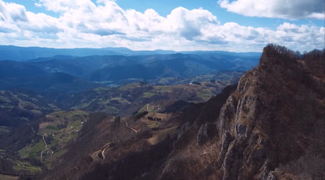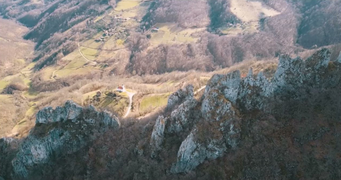Zarožje
Zarožje is a mountain village in Serbia within the Bajina Bašta municipality in the Zlatibor administrative district ( Okrug ) .
geography
Zarožje is located on the middle-eastern edge of the Dinaric Alps at an average altitude of 681 m . The highest point is the mountain Mali Povlen with 1347 m . Located in the Drina catchment area, the Rogačica tributary rises from the exposed Sokolina rock formation, which gave the village and the Rogačica river its name (Zarožje means “to / behind the horns”, Rogačica means “rising from the horns”).
Zarožje is located on the connecting road IIA Route 170, which connects the two cities of Valjevo and Bajina Bašta and leads through a mountain landscape. The path leads past widely scattered mountain villages, holiday homes and panoramas with a view of reservoirs and rivers. The road is particularly busy in the summer and winter months, as it leads to the Zlatibor tourist and ski area and the Tara National Park .
Zarožje extends over an area of 49.17 km² , which corresponds to 7.3% of the total area of the Bajina Bašta municipality. Of this, around 43% is covered with forest (mostly beech forests ).
history
Archaeological finds testify to the presence of a Roman and Celtic population in this region. Remains of early medieval buildings and churches prove the settlement of the region by a Serbian population. The area had been in the central rulership of Serbian empires and dynasties (see Serbian monarchs ) since the early Middle Ages .
In 1459 the region fell to the Ottoman Empire . With the fall of the Serbian despotism , the area loses its independence. In an Ottoman defter from 1476 there is a detailed description of the structure of citizens and households at that time: "14 households under the tribal elder Đurađ, son of Nikašin".
It can be speculated whether the remote settlement was founded in connection with the fall of Serbian rule. In contrast to older graves in the Stećci style , the grave inscriptions on site are rather simple or nonexistent. This could be an indication of less prosperous times. In addition, it is not known whether the centrally located church was destroyed or abandoned.
The more recent history of the settlement begins in the rebellious 1710s with the arrival of new settlers from the Crmnica areas (north of Lake Skadar ). At the same time, the village is first mentioned as "Zarožje". Upon their arrival, these people came across a winding mountain valley, difficult to reach from the outside, with the remains of the cult site “Misa”, near which there were several necropolises . The medieval tombs in the style of the Stećci were probably a well-known type of burial for the settlers, as these relics can also be found in their areas of origin. The connection between the settlement found and the settlers and why this partly inhospitable area was chosen as a new home is unknown. However, it may have been a proven retreat for Hajducken .
The region around the Drina River and its catchment area was the scene of various waves of migration in the 18th century to remote or uninhabited areas in the mountain regions of today's Serbia and Bosnia-Herzegovina , in the areas of the Danube Monarchy , but also in the areas of today's Ukraine ( Slavic Serbia ) . Most of them were Serbian farming families and Hajdukes, some of whom left their old homeland in what is now Montenegro and southern Bosnia ( Herzegovina ) under the leadership of the Serbian Orthodox Church . Similar to the Great Exodus of the Serbs in 1690, it was triggered by the deteriorating living conditions for the Christian population in the territories occupied by the Ottoman Empire at the time . In the remote mountain villages they were able to evade Ottoman rule (some local names and legends nevertheless remind of a certain presence of the Ottomans). The vampire legend about Sava Savanović is said to have originated during this time .
Until the beginning of the 18th century the village was known under the name "Misište". The place name is derived from a no longer existing monastery or place of prayer " Manastir Misa", which was located at the direct source of the Rogačica stream. A church was built at the presumed location in 1990. Since monasteries were often named after a local feature, it is believed that Misa had another meaning. Misa or Misište could be derived from the Latin Missa (church mass , service) and thus be a reference to a place of worship. Today the word Misište describes the hill on which the church is located. Based on the necropolis discovered around Misište, it is believed that it was originally a medieval settlement.
Until the middle of the 20th century, the area was almost completely cut off from the outside world and largely underdeveloped compared to the surrounding region. The writer Milovan Glišić drew the picture of a clearly underdeveloped region in his work Posle devedeset godina (Serbian: after ninety years) as early as 1880 .
After the mass migrations in the 17th and 18th centuries, the village experienced renewed population growth after the proclamation of the Principality of Serbia in 1815. The emerging years after the successful Second Serbian uprising against the Ottoman occupation brought the population the first schools and development even in the most remote places.
The village experienced a first wave of emigration after the end of the First World War , when the returning soldiers settled in more promising areas. During the Second World War , the village experienced a rapid decline in population. While many of the soldiers in the Jasenovac mass extermination camp were murdered by the Ustasha- Croatian regime, the rural population fell victim to the civil war . Statues and memorial plaques remember the events today.
It was only with the expansion of the asphalt expressway (magistralni put) in the 1970s, which connects the two cities of Valjevo and Bajina Basta, that the village received a better infrastructure. In the following years, a power grid was gradually built up. This event caused the population to decline after it peaked in 1961 with 1,583 residents. Since then, the population has decreased every year due to migration to other regions.
Attractions

Zarožje is known as a rustic and natural recreation area. Many holiday homes adorn the hilly landscape on the way from the Rovni reservoir to the heights of Jelovik. On the passage you come across various viewing platforms, called “ Vidikovac ”, which provide a view of the landscape. Since it is more of a transit area, the classic village tourism does not take place. The region is a popular hunting area.
Shielded by the surrounding mountains, legends and myths developed in the past centuries in the valley of the Rogačica stream. One of the most famous is the legend about the vampire Sava Savanović , who was a respected trader and Hajducke during his lifetime . After a tragic event in the village that cost him his life, he is said to have killed the millers at night in a water mill by the Rogačica stream and sucked their blood out of them. The villagers lived in fear of the vampire for a long time before they decided to open his grave to punch a sharpened stake through his heart.
Today you can visit the ruins and the former crime scene on the brittle bridge at the end of the jagged rock formation. Along the river there is an old chapel, the age of which is not known, and which is located in the middle of medieval tombs . The buildings and facilities have not yet been archaeologically researched. Some of the local necropolis have been added to the UNESCO World Heritage List.
population
From the 1970s onwards, many residents left Zarožje and went as guest workers , initially as seasonal workers , to Central Europe, mostly to Switzerland . Today you belong to the Serbian Diaspora in Switzerland. The village is therefore popularly known as “ mali Cirih ” (“ Little Zurich ”). Like most mountain villages in the former Yugoslavia , Zarožje is also very old, as most of the younger people prefer a life in the agglomeration .
Web links
Individual evidence
- ↑ Turizam. In: bajinabasta.rs. Retrieved August 27, 2018 (Serbian).
- ↑ a b c d e f g Obrad Dodić: Zarožje pod Povlenom . ISBN 978-86-7596-143-7 (Serbian).
- ↑ Sasha Ingber: The Bloody Truth About Serbia's Vampire. In: National Geographic. National Geographic, December 17, 2012, accessed August 29, 2018 .
- ↑ UNESCO: Stećci Medieval Tombstone Graveyards. In: whc.unesco.org. Accessed August 28, 2018 .








